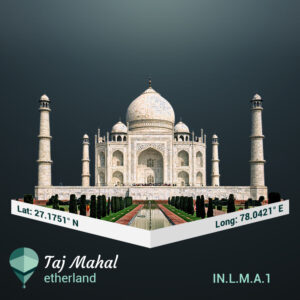
The first thing that comes to mind at the mention of India is the iconic Taj Mahal. This majestic ivory-white mausoleum represents the image of India on a global level. It was built by Mughal Emperor Shah Jehan in 1643 as a memorial for his favorite wife, Mumtaz Mahal. It is the jewel of Mughal art in India.
The construction of the Taj Mahal started in 1631 on the right bank of the river Yamuna in the city of Agra. The tomb is at the heart of a 17-hectare complex. The complete exterior, including the beautifully detailed arch-shaped doorway and large dome, is built of white marble. Four minarets are built on the corners of the tomb, giving it a basic indo-Islamic structural look. The white marble structure appears pink at dawn and changes to white as the day progresses. Inside the tomb are false graves of Mumtaz Mahal and Shah Jahan, while the actual graves are on the lower level, unreachable to the general public. Besides the tomb, there is a mosque, guest house, and gardens on four sides.
The monument's most eye-catching feature is the dome resting atop the tomb. The top of the dome is decorated with a lotus design. This design gives the dome a unique shape, and for this reason, it is often referred to as the onion dome. This distinctive design also accentuates the height of the dome to 7 meters. The dome is also joined by four smaller domes of similar shape. The column bases of these domes open through the roof to provide light to the interior. The symmetrical four minarets are 40 meters tall. On each minaret are two balconies, not open to the public, and on the top is the small dome.
As the Taj Mahal was built as a testimony of undying love by Shah Jahan for his wife, it is often remembered as a love symbol by romantics. The calligraphy on the great gate, or "Darwaza-e-Rauza," that welcomes visitors from the eastern side reads, "O Soul, thou art at rest. Return to the Lord at peace with Him, and He at peace with you." Other than this calligraphic writing, many other Quranic verses delicately calligraphed in the marble stones make the exterior detailed and elegant. Besides calligraphy, sculptures of flowers and vines are engraved on the exterior walls, making it picturesque.
In the gardens on all sides are flower beds that make the pathways appealing. The most picturesque location of the Taj Mahal is the raised marble water tank with a reflecting pool. This pool is positioned in such a way that the image of the tomb is reflected in clean water.
Taj Mahal is India's main tourist attraction, that garners millions of tourists every year. To cater to many visitors daily, the Indian administration has instituted a fine if tourists stay more than 3 hours to control over-tourism.
He tells stories of the glorious Muslim rule in India and rich Indian history. It was declared as the UNESCO World Heritage Site for being the "jewel of Muslim art in India" and "universally admired masterpieces of the world heritage." The Taj Mahal has also made it to the list of the New Wonders of the World.
The monument instills in itself rich history and extreme beauty. Bill Clinton, the ex-US President, once famously said, "There are two types of people on the Earth. Those who have seen the Taj Mahal and love it, and those who have not seen the Taj Mahal and love it." In which category do you fall?